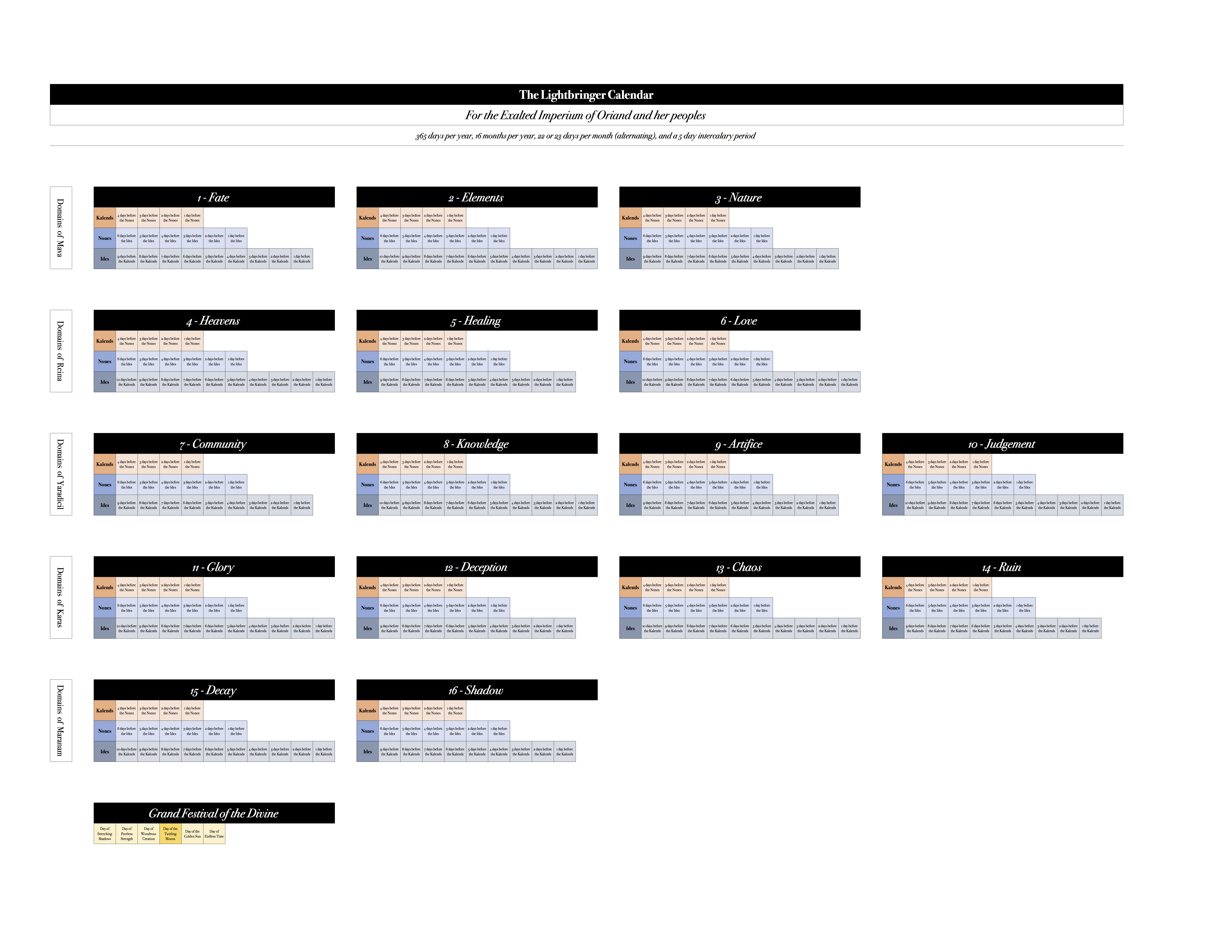Lightbringer Calendar
Used primarily by the Exalted Imperium of Oriand and its former territories, the Lightbringer calendar is a distinctly religious calendar. Named for Reina, grand goddess of the sun and patron of the Imperium, this calendar breaks the year into sixteen months, one for each of the domains of the grand gods. The year culminates in a five-day-long holy festival celebrating each of the five grand divine.
History
With the founding of the Exalted Imperium, it was decided that a new calendar system should be created to mark this momentous occasion. Given the theocratic nature of the Imperium, the calendar was designed to pay homage to the five grand divine as well as better educate the citizenry on religious doctrines. The Lightbringer calendar is organized to reflect the appearance of the grand divine as laid out in the Tale of Creation, as well as teach the general public each of the sixteen holy domains. Though worship of Reina is most encouraged by the Imperium, as reflected in the name of the calendar itself, each of the five grand divine is properly represented.Years
The transition from the Kingdom of Oriand to the Exalted Imperium of Oriand marks the starting year of the Lightbringer calendar. Each year lasts for 365 days, except on leap years. Leap years occur once every five years, adding a single day in the middle of the intercalary period.Months
The year is divided into sixteen months, with alternating lengths of 22 and 23 days. These months are named after the sixteen domains of the five grand divine and follow the order of their appearance. The typical Lightbringer calendar arrangement visually separates the domains, clearly showing the three domains of Mava and Reina, the four domains of Yaradicil and Karas, and the two domains of Maranam. The order of these domains is also intended to reflect the cycle of creation and destruction, though there is no historical precedent for this ordering system.Weeks
The Lightbringer calendar doesn't use a typical system of weeks, instead having three asymmetrical periods per month - the kalends, nones, and ides. The kalends marks the first of the month, the nones marks the sixth day of the month, and the ides marks the thirteenth day of the month. The date is stated as the remaining time until the next kalends, nones, or ides. For example, the fourth day in the month of Fate would be referred to as "2 days before the nones of Fate," or more colloquially, as "2 'til nones." The month of Shadow also follows this naming tradition, despite the intercalary period. Thus, "3 days before the kalends of Fate" would technically be 8 days prior, but the naming system is left unchanged for simplicity's sake.Intercalary Period
Altogether, the sixteen months account for only 360 days, leaving five days unaccounted for. The Lightbringer calendar remedies this by adding on the five days in between the last and first domain-months. These days are collectively called the Grand Festival of the Divine, with each day being exclusively for the celebration of one of the grand divine. The festival days go in the reverse order of appearance. Maranam, being last to appear, is the first festival day, and Mava, being first to appear, is the last. Maranam's day is called the Day of Stretching Shadows, Karas' day is called the Day of Peerless Strength, Yaradicil's day is called the Day of Wondrous Creation, Reina's day is called the Day of the Golden Sun, and Mava's day is called the Day of Endless Time. This reverse order reflects the changing of the years, returning from the empty winter to the blooming spring. On leap years, an extra day is added to the festival before the Day of the Golden Sun. This day is for the sisters and handmaidens of Reina, Lua and Esta , and is called the Day of the Twirling Moons.Remove these ads. Join the Worldbuilders Guild









Comments